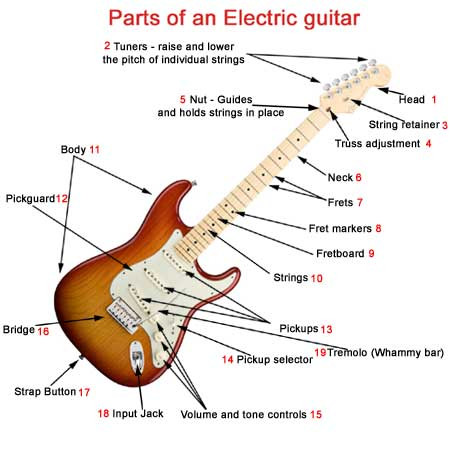Electric guitars are iconic instruments that have shaped modern music. While seemingly simple on the surface, a closer look reveals a carefully designed machine where each component plays a crucial role in its sound and playability. Understanding the parts of an electric guitar is fundamental for any guitarist, whether you’re just starting out or looking to deepen your knowledge of your instrument. This guide will break down each essential part, explaining its function and contribution to the overall electric guitar experience.
 Diagram of the parts of an electric guitar, clearly labeling the headstock, tuners, neck, fretboard, body, pickups, bridge, and controls. Essential anatomy of an electric guitar explained for beginners.
Diagram of the parts of an electric guitar, clearly labeling the headstock, tuners, neck, fretboard, body, pickups, bridge, and controls. Essential anatomy of an electric guitar explained for beginners.
Let’s explore the anatomy of an electric guitar, starting from the top and working our way down:
1. The Headstock
The headstock is located at the very top of the guitar neck. This section of the guitar serves as the anchor point for the tuners and often displays the manufacturer’s logo and model. The design and size of the headstock can influence the guitar’s resonance and sustain.
2. Tuners (Machine Heads)
Also known as machine heads or tuning pegs, the tuners are situated on the headstock. These are mechanical gears used to adjust the tension of the strings, thereby changing their pitch. By rotating the tuners, you can accurately tune each string to the desired note. Tuners come in various styles, but their primary function remains the same: precise and stable tuning.
3. String Retainers (String Trees)
Often found on guitars with angled headstocks like the Fender Stratocaster, string retainers are small metal components that ensure the strings maintain proper downward pressure over the nut. This prevents string buzzing and ensures consistent contact with the nut slots, which is crucial for clear tone and tuning stability, especially for the strings furthest from the headstock.
4. Truss Rod Adjustment
The truss rod is a steel rod embedded within the guitar neck. It’s adjustable and counteracts the immense tension exerted by the strings, preventing the neck from bowing or warping over time. The truss rod adjustment point, usually located on the headstock or near the body, allows for fine-tuning the neck’s curvature (relief). While adjusting the truss rod is vital for optimal playability and preventing string buzz, it’s generally recommended that beginners seek guidance from an experienced guitarist or a professional guitar technician to avoid damaging the instrument.
5. The Nut
The nut is a small, typically plastic, bone, or composite piece located at the junction of the headstock and the fretboard. It features precisely cut slots that guide and space the strings as they extend from the headstock to the fretboard. The nut’s height and slot depth are critical for setting the string action (height above the frets) at the headstock end of the neck. A well-cut nut is essential for comfortable playing and preventing string buzz, contributing significantly to both playability and open string tone.
6. The Neck
The neck is the long wooden component extending from the guitar body, serving as the foundational structure for the fretboard, frets, headstock, and tuners. The neck’s profile (shape of the wood in cross-section) and material significantly impact the guitar’s feel and playability. Inside the neck resides the truss rod, providing crucial structural support and adjustability.
7. Frets
Frets are thin metal strips embedded across the fretboard at precise intervals. These intervals are calculated based on the guitar’s scale length to create accurate musical intervals. When you press a string down between two frets, the fret acts as the termination point of the vibrating string length, shortening it and thus raising the pitch to a specific note. Frets enable guitarists to play different notes consistently across the fretboard.
8. Fret Markers (Inlays)
Fret markers, also known as inlays, are visual guides embedded into the fretboard. Typically dots or other shapes, they are usually located at frets 3, 5, 7, 9, 12 (often a double marker), 15, 17, 19, 21, and 24. Fret markers help guitarists quickly and easily navigate the fretboard, especially in low-light conditions or during fast playing. They become intuitive reference points for experienced players.
9. Fretboard (Fingerboard)
The fretboard is the wooden surface atop the guitar neck where the frets are embedded. It’s the playing surface where your fingers press down on the strings to produce notes and chords. Common fretboard woods include rosewood, maple, and ebony, each contributing slightly different tonal characteristics and playing feel. The fretboard radius (curvature across its width) also influences playing comfort.
10. Strings
Electric guitars typically use six strings, though 7 and 8-string guitars are also common, especially in heavier genres of music. Strings are numbered from 1st to 6th, with the 1st string being the thinnest (high E) and the 6th string being the thickest (low E in standard tuning). String gauge (thickness) affects playability and tone; lighter gauges are easier to bend but can sound thinner, while heavier gauges offer a fuller tone but require more finger strength. Changing string gauges may necessitate adjustments to the guitar’s setup.
11. The Body
The body is the main resonant component of the electric guitar and provides the foundation for attaching the neck, bridge, pickups, and controls. Unlike acoustic guitars which rely on a hollow body for volume, electric guitar bodies are often solid wood, though semi-hollow and hollow body electric guitars also exist. The body wood type, shape, and construction significantly influence the guitar’s sustain, tone, and overall weight.
12. The Pickguard
The pickguard is a plastic or sometimes metal plate mounted to the guitar body. Its primary function is to protect the body’s finish from scratches caused by guitar picks. On some guitar models, like the Fender Stratocaster and Telecaster, the pickguard also serves as a mounting surface for the pickups and some of the electronic components, simplifying wiring and assembly.
13. Pickups
Pickups are the electro-magnetic transducers that are fundamental to what makes an electric guitar “electric.” Positioned beneath the strings, pickups consist of magnets wrapped in wire coils. They detect the vibrations of the metal strings and convert these mechanical vibrations into a weak electrical signal. Different types of pickups (single-coil, humbucker, P90) have distinct tonal characteristics, significantly shaping the guitar’s sound. Changing pickups is a common way to alter an electric guitar’s tone.
14. Pickup Selector Switch
On guitars equipped with multiple pickups (typically two or three), the pickup selector switch allows you to choose which pickup(s) are active. This switch modifies the guitar’s tone, as each pickup position captures a different tonal spectrum. Common configurations include neck pickup only, bridge pickup only, or combinations of neck and bridge or middle pickups for a wider range of sounds.
15. Volume and Tone Controls
Volume and tone knobs are potentiometers that allow you to adjust the output volume and the tonal color of the guitar signal. The volume control regulates the overall signal strength going to the amplifier. Tone controls typically act as a low-pass filter, rolling off high frequencies (treble) to create a warmer, darker tone. Some guitars have multiple tone controls that may affect different pickups or frequency ranges.
16. The Bridge
The bridge is located on the guitar body and serves two primary functions: it anchors the strings at the body end and it allows for adjusting the string height (action) and intonation. Intonation is the accuracy of pitch up and down the fretboard. Different bridge types exist, including fixed bridges (providing maximum stability and sustain), tremolo bridges (allowing for vibrato and pitch bending effects), and tune-o-matic bridges (common on Gibson-style guitars). Saddles, small adjustable components on the bridge, are used to set the intonation for each string individually.
17. Strap Buttons
Strap buttons are small knobs or posts attached to the guitar body, designed to secure a guitar strap. For safety and security, especially when playing standing up, locking strap buttons are highly recommended. These prevent the strap from accidentally detaching and potentially dropping the guitar.
18. Output Jack
The output jack (sometimes mistakenly labeled “input” on diagrams) is a socket on the guitar body where you plug in a guitar cable. It is the point where the electrical signal generated by the pickups is transmitted from the guitar to an amplifier, effects pedals, or recording interface. The output jack is a crucial connection point for getting sound from your electric guitar.
19. Tremolo Bar (Whammy Bar)
The tremolo bar, often called a whammy bar or vibrato bar, is an optional lever attached to certain types of bridges, particularly tremolo bridges like those found on Stratocaster-style guitars. By manipulating the tremolo bar, you can change the string tension and thus create vibrato or dramatic pitch-bending effects, adding expressive sonic textures to your playing.
Understanding the parts of an electric guitar empowers you to communicate more effectively with guitar technicians, make informed decisions about upgrades or repairs, and ultimately, deepen your connection with your instrument. As you continue your guitar journey, this knowledge will become increasingly valuable in shaping your sound and maintaining your guitar for years to come.

